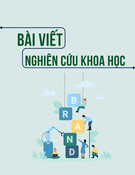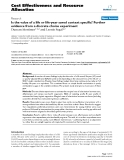
JST: Engineering and Technology for Sustainable Development
Volume 35, Issue 1, March 2025, 044-050
44
The Effect of Nutritional and Environment Information on Consumer’s
Willing-To-Pay for Products Containing an Upcycled Ingredient
Doan Duy Le Nguyen 1*, My Phung Huynh Diep 2,3, Quoc Cuong Nguyen 2,3
1 Faculty of Food Science and Technology, Ho Chi Minh City University of Industry and Trade,
Ho Chi Minh City, Vietnam
2 Department of Food Technology, Ho Chi Minh City University of Technology, Ho Chi Minh City, Vietnam
3 Vietnam National University Ho Chi Minh City, Ho Chi Minh City, Vietnam
*Corresponding author email: duylnd@huit.edu.vn
Abstract
With the aim of figuring out which product attributes influence consumers' willingness to pay for upcycled food
and to investigate the consumers’ attitudes to the upcycled food in Vietnam, the research aims to introduce
upcycled food to Vietnamese consumers and investigate which information affects willingness to pay for an
upcycled food, that is biscuit products adding spent coffee grounds (SCG). A choice experiment was
conducted with more than 200 consumers, who are students at universities in Vietnam. Using Multinominal
Logit Model (MNL) and Mixed Multinominal Logit Model (MMNL), it is found that the consumers concern about
three information price, antioxidant, and coffee flavour, and they do not pay attention to type of flour, carbon
trust information. Among the relevant information, consumers are willing-to-pay a premium 31.4 thousand
VND and 19.6 thousand VND for antioxidant and coffee flavour. These findings provide insights into market
opportunities and policy implementation regarding the production of upcycled food. Furthermore, the study
highlights the potential of using upcycled ingredients to reduce food waste into the environment.
Keywords: Choice experiment, multinominal logit model, spent coffee grounds (SCG), upcycled food, willing
to pay.
1. Introduction1
1.1. From Food Waste to Upcycled Food
Recent years have seen a resurgence of interest in
the upcycling movement as environmental worries
over resource usage and waste levels have grown. The
term "upcycling" refers to the practice of "repurposing,
repairing, upgrading, and remanufacturing products
and materials that are no longer in use or are about to
be disposed of in a way that increases their value" [1].
The food business has recently seen a rise in the
practice of "upcycling" which involves using leftover
food and food waste to create items like animal feed,
cosmetics, nutraceuticals, and dietary supplements.
Upcycling is being considered by food enterprises as a
potential strategy to decrease the quantity of food
waste they produce. According to estimates from the
United Nations, approximately one-third of the food
produced worldwide is wasted or lost annually. This
includes food that is left on restaurant plates, edible
food that is left uneaten, crops left in the field, food
that spoils during transportation, and food that is not
made it to stores. This amounts to 1.3 billion tons of
food, or enough to feed 3.5 billion people, at a cost of
ISSN 2734-9381
https://doi.org/10.51316/jst.180.etsd.2025.35.1.6
Received: Jul 8, 2024; revised: Aug 26, 2024;
accepted: Oct 12, 2024
almost US $1 trillion [2]. Furthermore, food waste is
extremely harmful to the environment and natural
resources, accounting for 10% of greenhouse gas
emissions worldwide. Food waste contributes more to
global warming than vehicle emissions because it
produces methane, which is thought to be eight times
more dangerous than carbon, when it ends up in
landfills [3]. One strategy that can, in part, lessen the
negative impacts of food waste is upcycling. Food
by-products, visually defective produce (sometimes
unsightly to sell because of colour or appearance),
food scraps, and excess food are all used in upcycling
to create new items.
1.2. Coffee and Spent Coffee Grounds
1.2.1. Benefits and challenges
Coffee is the second most traded commodity after
petroleum and one of the most popular drinks
worldwide. Coffee is a major global industry with
around 80 countries cultivating coffee. Additionally
well-liked and consumed throughout the world, coffee
has been linked in epidemiological research to a lower
risk of cancer, heart disease, and non-alcoholic fatty
liver disease. Spent coffee grounds disposal presents a




















